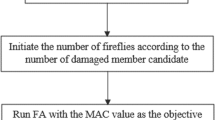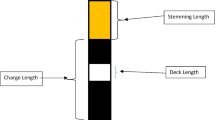Abstract
Based on the Cao Mao mountain cross-tunnel project, on-site monitoring and theoretical study of the blasting vibration effect of the cross-tunnel were carried out, and the dynamic response of the existing tunnel under instantaneous explosion loads was analyzed. The equivalent radius of action (re) was introduced to replace the maximum charge per delay (Q) to improve the traditional prediction equations for the peak particle velocity (PPV) and the main frequency (fc). When the intersection is used as the boundary, the attenuation of the PPV and fc can be studied separately. The results show that the effect of blasting vibrations in front of and behind the face is affected by the free surface. The blasting vibration alarm value, the early warning value, and the natural frequency of the existing tunnel are regarded as safety control limits. The controlled blasting distance of the cross tunnel can be obtained by regression calculation. In addition, the mathematical relationship between the PPV and fc is used to quantitatively consider the influence of the frequency on the blasting safety vibration threshold, compensating for the lack of consideration of the influence of the frequency in various national blasting safety regulations or standards.




















Similar content being viewed by others
Abbreviations
- PPV :
-
Peak particle velocity
- PPV 0 :
-
Peak particle velocity on the blasthole wall
- R :
-
Distance from the blast area
- D :
-
Distance between the tunnel face and the intersection
- K :
-
Relevant parameters of blasting vibration
- α :
-
Relevant parameters of blasting vibration
- Q :
-
Maximum charge per delay
- E :
-
Elastic modulus of rock mass
- r 1 :
-
Radius of the blasting crushing zone
- r 2 :
-
Radius of the broken zone
- r e :
-
Equivalent radius of action
- p 0 :
-
Initial pressure in the blasthole
- σ*:
-
Dynamic compressive strength of the rock mass
- p e :
-
Equivalent blasting load
- ρ :
-
Rock density
- ρ e :
-
Density of explosives
- C p :
-
Longitudinal wave propagation velocity of the rock
- σ c :
-
Uniaxial compressive strength of rock mass
- σ t :
-
Uniaxial tensile strength of rock mass
- d a :
-
Diameter of the explosive
- d b :
-
Blasthole diameter
- D Φ :
-
Detonation wave velocity
- μ :
-
Poisson's ratio
- q :
-
Unit consumption of blasting rock
- s:
-
Distance between two adjacent blastholes
- f c :
-
Main frequency
References
Chen G, Li Q, Li D, Wu Z, Liu Y (2019) Main frequency band of blast vibration signal based on wavelet packet transform. Appl Math Model 74:569–585. https://doi.org/10.1016/j.apm.2019.05.005
Deng X, Wang J, Wang R, Liu Q (2020) Influence of blasting vibrations generated by tunnel construction on an existing road. Int J Civ Eng 18:1381–1393. https://doi.org/10.1007/s40999-020-00549-w
Dragomiretskiy K, Zosso D (2014) Variational mode decomposition. IEEE t Signal Proces 62:531–544. https://doi.org/10.1109/TSP.2013.2288675
Duan B, Xia H, Yang X (2018) Impacts of bench blasting vibration on the stability of the surrounding rock masses of roadways. Tunn Undergr Sp Tech 71:605–622. https://doi.org/10.1016/j.tust.2017.10.012
Favreau RF (1969) Generation of strain waves in rock by an explosion in a spherical cavity 1969. J Geophys Res 74:4267–4280
Guan X, Zhang L, Wang Y, Fu H, An J (2020) Velocity and stress response and damage mechanism of three types pipelines subjected to highway tunnel blasting vibration. Eng Fail Anal 118:104840. https://doi.org/10.1016/j.engfailanal.2020.104840
Hosseini SA, Tavana A, Abdolahi SM, Darvishmaslak S (2019) Prediction of blast-induced ground vibrations in quarry sites: a comparison of GP, RSM and MARS. Soil Dyn Earthq Eng 119:118–129. https://doi.org/10.1016/j.soildyn.2019.01.011
Hustrulid W (1999) Blasting principles for open pit mining.Volume1-General design concepts 1999. A.A.Balkema/ Rotterrad/Brookfield
Hustrulid W, Bennett R, Ashland F, Lenjani M (1992) A new method for predicting the extent of the blast damaged zone. Proceeding of the Sprangteknisk Konferens 1992. Nitro Nobel, Goteberg-Kiel, Jan 15–16, 55
Hustrulid W, Lu W (2002) Some general design concepts regarding the control of blast -induced damage during rock slope excavation 2002. Proc.7th Rock Fragmentation by Blasting , Beijing, Aug 12–15, 595–604
Jayasinghe B, Zhao Z, Tecl Chee AG, Zhou H, Gui Y (2019) Attenuation of rock blasting induced ground vibration in rock-soil interface. J Rock Mech Geotech Eng 11:770–778. https://doi.org/10.1016/j.jrmge.2018.12.009
Ji L, Zhou C, Lu S, Jiang N, Gutierrez M (2021) Numerical studies on the cumulative damage effects and safety criterion of a large cross-section tunnel induced by single and multiple full-scale blasting. Rock Mech Rock Eng 54:6393–6411. https://doi.org/10.1007/s00603-021-02630-9
Jiang W, Arslan CA, Soltani Tehrani M, Khorami M, Hasanipanah M (2019) Simulating the peak particle velocity in rock blasting projects using a neuro-fuzzy inference system. Eng Comput Germany 35:1203–1211. https://doi.org/10.1007/s00366-018-0659-6
Kumar S, Mishra AK, Choudhary BS, Sinha RK, Deepak D, Agrawal H (2020) Prediction of ground vibration induced due to single hole blast using explicit dynamics. Mining, Metallurgy & Exploration 37:733–741. https://doi.org/10.1007/s42461-019-00162-z
Langhaar HL (1951) Dimensional analysis and theory of models. Wiley, New York
Li L, Wang F, Shang F, Jia Y, Zhao C, Kong D (2017a) Energy spectrum analysis of blast waves based on an improved Hilbert-Huang transform. Shock Waves 27:487–494. https://doi.org/10.1007/s00193-016-0667-7
Li X, Hu H, He L, Li K (2017b) An analytical study of blasting vibration using deep mining and drivage rules. Clust Comput 20:109–120. https://doi.org/10.1007/s10586-017-0736-4
Li JC, Li HB, Ma GW, Zhou YX (2013) Assessment of underground tunnel stability to adjacent tunnel explosion. Tunn Undergr Sp Tech 35:227–234. https://doi.org/10.1016/j.tust.2012.07.005
Liang Q, Li J, LI D (2013) Effect of blast-induced vibration from new railway tunnel on existing adjacent railway tunnel in Xinjiang. China Rock Mech Rock Eng 46:19–39. https://doi.org/10.1007/s00603-012-0259-5
Liu D, LU WB, Chen M (2018) Attenuation formula of the dominant frequency of blasting vibration during tunnel excavation. Chin J Rock Mech Eng 37(09):2015–2026. https://doi.org/10.13722/j.cnki.jrme.2018.0311(inChinese)
Lu W, Leng Z, Hu H, Chen M, Wang G (2018) Experimental and numerical investigation of the effect of blast-generated free surfaces on blasting vibration. Eur J Environ Civ En 22:1374–1398. https://doi.org/10.1080/19648189.2016.1262285
Lu WB, Hustrulid W (2002) Improvement of the attenuation formula for the peak vibration velocity of the particle. Engineering Blasting (03):1–4. https://kns.cnki.net/kcms/detail/detail.aspx?FileName=GCBP200203000&DbName=CJFQ2002 (in Chinese)
Pavlov MM (1981) Maximum particle velocities in the wave dur-ing explosion cylindrical charges in rocks 1981 . Fiz Goreniya Vzryva 3
Peng Y, Liu G, Wu L, Zuo Q, Liu Y, Zhang C (2021) Comparative study on tunnel blast-induced vibration for the underground cavern group. Environ Earth Sci. https://doi.org/10.1007/s12665-020-09362-z
Shan RL, Zhao Y, Wang HL, Dong J, Wang DS (2022) Research on the attenuation law of blasting vibration in tunnel engineering. Arab J Geosci. https://doi.org/10.1007/s12517-022-09899-2
Triviño LF, Mohanty B, Milkereit B (2012) Seismic waveforms from explosive sources located in boreholes and initiated in different directions. J Appl Geophys 87:81–93. https://doi.org/10.1016/j.jappgeo.2012.09.004
Wang X, Li J, Zhao X, Liang Y (2022) Propagation characteristics and prediction of blast-induced vibration on closely spaced rock tunnels. Tunn Undergr Sp Tech 123:104416. https://doi.org/10.1016/j.tust.2022.104416
Wang Z, Wang H, Wang J, Tian N (2021) Finite element analyses of constitutive models performance in the simulation of blast-induced rock cracks. Comput Geotech 135:104172. https://doi.org/10.1016/j.compgeo.2021.104172
Yang C, Zhou K, Gao R, Xiong X (2021) Numerical investigation of the dynamic response of a preconditioned roof in an underground mine: a case study of mining environment regeneration. Soil Dyn Earthq Eng 140:106457. https://doi.org/10.1016/j.soildyn.2020.106457
Yang J, Cai J, Yao C, Li P, Jiang Q, Zhou C (2019) Comparative study of tunnel blast-induced vibration on tunnel surfaces and inside surrounding rock. Rock Mech Rock Eng 52:4747–4761. https://doi.org/10.1007/s00603-019-01875-9
Yang JH, Lu WB, Chen M (2012) An equivalent simulation method for blasting vibration of surrounding rock. Explosion and Shock 32(02):157–163 (in Chinese)
Yang JH, Lu WB, Jiang QH, Yao C, Zhou CB (2016) Frequency comparison of blast-induced vibration per delay for the full-face millisecond delay blasting in underground opening excavation. Tunn Undergr Sp Tech 51:189–201. https://doi.org/10.1016/j.tust.2015.10.036
Yu C, Yue H, Li H, Xia X, Liu B (2021) Scale model test study of influence of joints on blasting vibration attenuation. B Eng Geol Environ 80:533–550. https://doi.org/10.1007/s10064-020-01944-2
Zaid M (2021) Dynamic stability analysis of rock tunnels subjected to impact loading with varying UCS. Geomech Eng 24:505–518. https://doi.org/10.12989/GAE.2021.24.6.505
Zhang Z, Zhou C, Remennikov A, Wu T, Lu S, Xia Y (2021) Dynamic response and safety control of civil air defense tunnel under excavation blasting of subway tunnel. Tunn Undergr Sp Tech 112:103879. https://doi.org/10.1016/j.tust.2021.103879
Zhao Y, Shan RL, Wang HL, Tong X, Li YH (2021) Regression analysis of the blasting vibration effect in cross tunnels. Arab J Geosci 14:1925. https://doi.org/10.1007/s12517-021-08257-y
Zhong G, Ao L, Zhao K (2012) Influence of explosion parameters on wavelet packet frequency band energy distribution of blast vibration. J Cent South Univ 19:2674–2680. https://doi.org/10.1007/s11771-012-1326-5
Zhou JR, Lu WB, Zhong DW, Leng ZD, Wu L, Yan P (2019) Prediction of frequency-dependent attenuation of blast-induced vibration in underground excavation. Eur J Environ Civ En 1–18. https://doi.org/10.1080/19648189.2019.1620134
Funding
The work described in this paper is supported by the National Natural Science Foundation of China (number: 51878242) and the Natural Science Foundation of Hebei Province (number: E2020404007).
Author information
Authors and Affiliations
Corresponding author
Ethics declarations
Conflict of interest
The authors declare no competing interests.
Rights and permissions
Springer Nature or its licensor holds exclusive rights to this article under a publishing agreement with the author(s) or other rightsholder(s); author self-archiving of the accepted manuscript version of this article is solely governed by the terms of such publishing agreement and applicable law.
About this article
Cite this article
Zhao, Y., Shan, R., Wang, H. et al. Vibration response and evaluation system of cross-tunnel blasting. Bull Eng Geol Environ 81, 417 (2022). https://doi.org/10.1007/s10064-022-02911-9
Received:
Accepted:
Published:
DOI: https://doi.org/10.1007/s10064-022-02911-9




